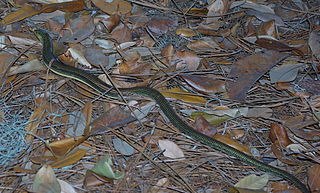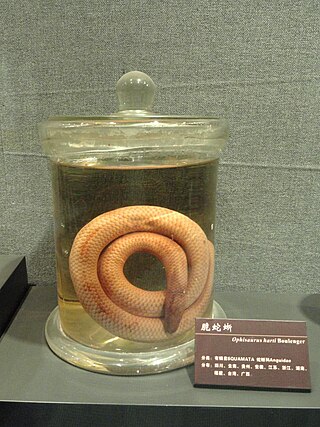
Anguidae refers to a large and diverse family of lizards native to the Northern Hemisphere. Common characteristics of this group include a reduced supratemporal arch, striations on the medial faces of tooth crowns, osteoderms, and a lateral fold in the skin of most taxa. The group is divided into two living subfamilies, the legless Anguinae, which contains slow worms and glass lizards, among others, found across the Northern Hemisphere, and Gerrhonotinae, which contains the alligator lizards, native to North and Central America. The family Diploglossidae was also formerly included. The family contains about 87 species in 8 genera.

Ophisaurus is a genus of superficially snake-like legless lizards in the subfamily Anguinae. Known as joint snakes, glass snakes, or glass lizards, they are so-named because their tails are easily broken; like many lizards, they have the ability to deter predation by dropping off part of the tail, which can break into several pieces, like glass. The tail remains mobile, distracting the predator, while the lizard becomes motionless, allowing eventual escape. This serious loss of body mass requires a considerable effort to replace, and can take years to do so. Despite this ability, the new tail is usually smaller than the original.

The slender glass lizard is a legless lizard in the glass lizard subfamily (Anguinae). The species is endemic to the United States. Two subspecies are recognized. The lizard was originally believed to be a subspecies of the eastern glass lizard. Their name comes from their easily broken tail which they can break off themselves without ever being touched. It is difficult to find a specimen with an undamaged tail. The lizard eats a variety of insects and small animals, including smaller lizards. Snakes and other animals are known to prey on the species. Humans have a part in destroying their environment and killing their food supply with insecticides. The lizard is considered to be a least-concern species according to the International Union for Conservation of Nature (IUCN), though it is vulnerable in Iowa and endangered in Wisconsin. It is important to note that the streamlined, legless species is often confused with snakes. Glass Lizards, however, differ from snakes as they possess a moveable eyelid, which is absent in snakes. Another way to distinguish glass lizards from snakes is the presence of an external ear opening, which are absent in snakes.

The sheltopusik, also commonly called Pallas's glass lizard, the European legless lizard, or the European glass lizard, is a species of large glass lizard found from Southern Europe to Central Asia.

The broad-headed skink or broadhead skink is species of lizard, endemic to the southeastern United States. The broadhead skink occurs in sympatry with the five-lined skink and Southeastern five-lined skink in forest of the Southeastern United States. All three species are phenotypically similar throughout much of their development and were considered a single species prior to the mid-1930s.

Dopasia gracilis, known commonly as the Asian glass lizard, the Burmese glass lizard, or the Indian glass snake, is a species of legless lizard in the family Anguidae. The species is endemic to Asia.

The six-lined racerunner is a species of lizard native to the United States and Mexico.

Koelliker's glass lizard, also called commonly the Moroccan glass lizard, is a species of lizard in the family Anguidae. The species is native to western North Africa.

Abronia mitchelli, Mitchell's arboreal alligator lizard, is a species of arboreal alligator lizard in the family Anguidae. The species, which was originally described in 1982 by Jonathan A. Campbell, is endemic to southwestern Mexico.

The eastern glass lizard is a species of legless lizard in the family Anguidae, endemic to the Southeastern United States. The streamlined, legless species is often confused with snakes. Glass lizards differ from snakes as they possess a moveable eyelid and an external ear opening, both of which are absent in snakes. Ventralis comes from the Latin "venter" meaning belly; this is in reference to the snake-like movement.

The island glass lizard is a species of lizard in the family Anguidae. The species is endemic to the southeastern United States.

The brown water snake is a large species of nonvenomous natricine snake endemic to the southeastern United States. This snake is often one of the most abundant species of snakes found in rivers and streams of the southeastern United States, yet many aspects of its natural history is poorly known. Due to abundance and distribution throughout its biological range, this species could be used to investigate anthropogenic impacts on aquatic ecosystems by studying their movements.

Abronia campbelli, commonly known as Campbell's alligator lizard, is species of critically endangered arboreal alligator lizard in the family Anguidae. Abronia campbelli is endemic to eastern Guatemala.

The Madrean alligator lizard is a species of lizard in the family Anguidae. The species is endemic to the southwestern United States and adjacent northwestern Mexico.

Dopasia is a genus of lizards in the family Anguidae. The genus contains seven species, which are native to Asia. They are most closely related to the North American Ophisaurus, and are sometimes considered part of that genus.
Dopasia buettikoferi, also known commonly as the Bornean glass snake and Buettikofer's glass lizard, is a species of lizard in the family Anguidae. The species is native to Indonesia and Malaysia on the island of Borneo.

Dopasia harti, also known commonly as the Chinese glass lizard and Hart's glass lizard, is a species of lizard in the family Anguidae. The species is native to southeastern Asia.
Ophisaurus incomptus, the plainneck glass lizard, is a species of lizard of the Anguidae family. It is found in Mexico.
Gerrhonotus farri, also known commonly as Farr's alligator lizard and the Tamaulipan alligator lizard, is a species of lizard in the family Anguidae. The species is native to northeastern Mexico.

















